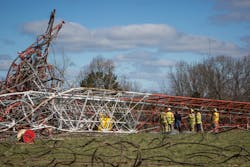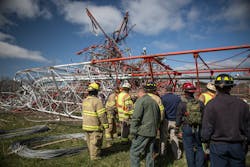MO Crews Respond to Scene of Fatal Antenna Collapse
In the fire service, you see a lot of different types of calls. Rarely is one call just like the previous, and sometimes a call can throw you a curveball that you never could have imagined.
Collapse response
On April 18, the tones went off at 9:46 a.m., and the crew from the Rogersville, MO, Fire Protection District headed to a call like they had never experienced. A mutual-aid call had been requested for a tower collapse with entrapment in the neighboring town of Fordland.
The town of Fordland is home to the area’s tallest TV antennas. The antenna that collapsed was just over 1,900 feet in height and had been under renovation. There were six workers servicing the tower at a height of about 105 feet above the ground when the tower twisted. All but one of the workers—the owner of the tower service company—was able to quickly climb down.
Rogersville Fire Chief Richard Stirts said that upon arrival to the site, he established a unified command with two other mutual-aid fire departments, Southern Webster County and Seymour Fire, as well as the Webster County Sherriff’s Office. They quickly identified hazards and set up a plan with three goals:
- Secure the electricity going to the tower. There was a backup generator running and the tower had fallen across powerlines leading to the communications building at the base of the tower.
- Preserve evidence and investigative in order to determine whether this was a criminal act or a workplace accident, and in either case, to document the evidence.
- Remove the victim.
Once the power had been cut to the worksite, the crews assessed that the victim could be removed with the use of a telescoping forklift on site. Seymour Fire Chief Shawn Crump along with Cox Hospital Paramedic Fred Cox and Rogersville Firefighter-Paramedic Mike Robinson devised a plan to use tow cables to lift the basket and debris off the victim for the extrication.
Once the crews started to move the metal with the forklift, they found that the mass was stable and safe to work around; however, some of the metal was attached to steel cables and guy-wires, so careful movements were needed to safely remove the debris. The process took about 30 minutes to complete.
Had the victim been under the main debris pile, the extraction would have taken much longer, as the crews later discovered that the tools on the trucks, like the extrication equipment, could only cut the cross-members of the tower supports and only cut one small section at a time due to the size and strength of the steel. The main support of the antenna, the outer triangle post, is made of 6-inch solid steel, so only high-strength gas cutters would cut the steel. None of the local fire departments have that big of a cutting torch on the trucks, and would have had to allocate those from an outside source had they needed one. One source would have been to reach out to the railroad and solicit help from them.
Takeaways
Like most fire services, Rogersville Fire Protection trains for many common occurrences. This one was new to them and probably would have been new to many of the fire services across the United States.
These towers are everywhere but rarely do they fail and cause an entrapment. Through tragic events, we learn and can hopefully take steps to help prevent the next big accident, and we are also able to help pass the education on to others.
A key takeaway from this incident was the need for additional training on high-angle rescue training, trench entrapment, and working to shore up unstable loads. It is also important to learn more about cutting steel that is under tension, and how to manage sharp shards of broken steel and guy-wires strewn across the work area. Additionally, the incident is a reminder of the need to be vigilant when working around electrical hazards.
For more
For more information on this incident, contact PIO/Assistant Chief Robert Talburt at Logan-Rogersville Fire Protection District at (785) 753-4265.
About the Author
Joe Thomas
Joe Thomas is a freelance photographer with Greenbox Photography. He is a volunteer photographer for the Logan-Rogersville, MO, Fire Protection District and the Ozark, MO, Fire Protection District.


